Never miss an issue of Classic & Sports Car and save money when you subscribe! Check out our latest offers
Bugattis are said to be partly works of art and partly works of engineering.
Which parts are attributed to each discipline, and in what proportion, is not always easy to identify but, given the make’s dominance in competition (the Type 35 won more than 1000 races between 1926 and ’32, including five Targa Florios), it was a pretty well-judged cocktail.
Bugatti’s solutions were at times hideously complicated, with function subordinate to elegance of form, yet managed to be strong and reliable where it counted.
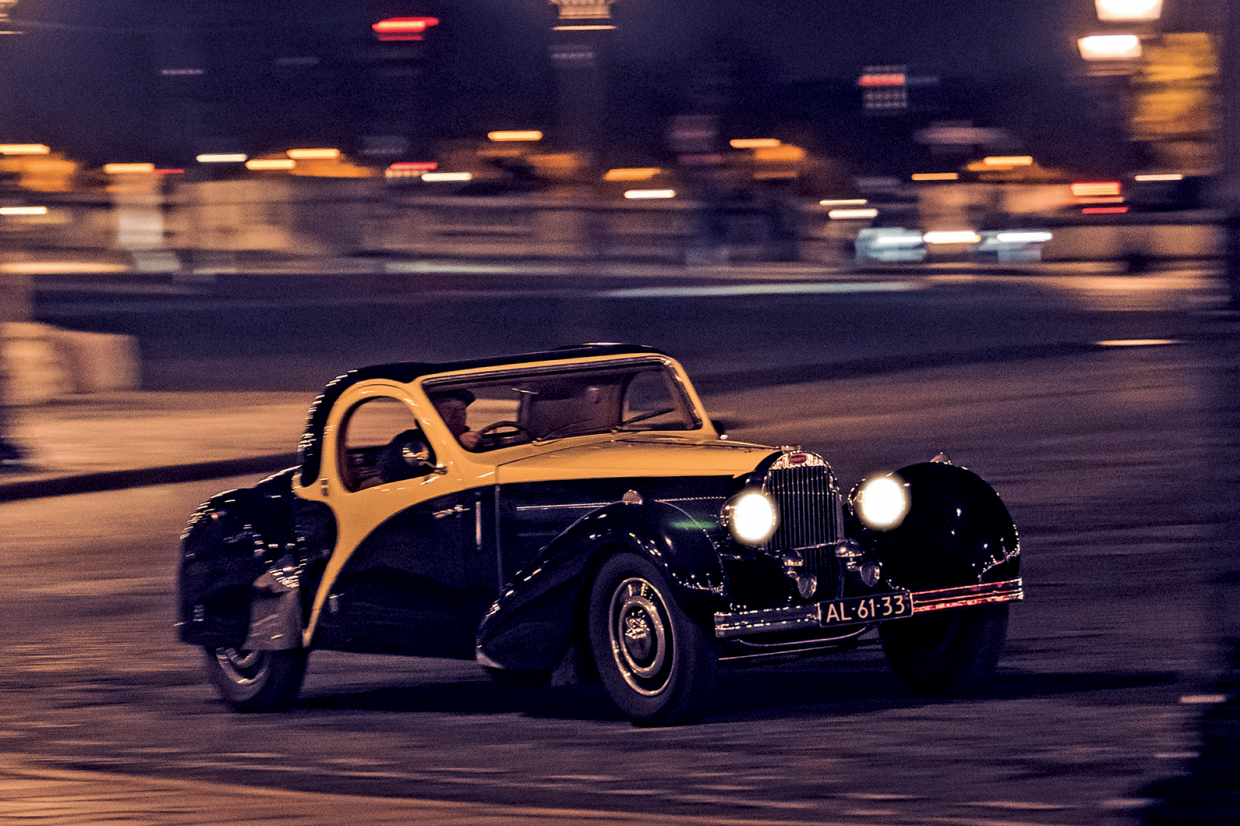 Few vehicles can match the glamour of Paris by night – this Bugatti Type 57 Atalante is certainly one of them
Few vehicles can match the glamour of Paris by night – this Bugatti Type 57 Atalante is certainly one of them
Even quite mundane components, made with the finest materials, were produced in-house at the picturesque Molsheim factory that Ettore Bugatti ran like a feudal prince.
His cars were generally at the leading edge of technology, yet also stubbornly backward in areas with details that occasionally exposed Ettore as more of a gifted draughtsman than a true engineer.
He came from a highly creative Milanese family – grandfather Carlo was a celebrated furniture designer, younger brother Rembrandt an outstanding sculptor – and you can see this in most of the dozens of cars he designed in a 30-year search for aesthetic and technical perfection.
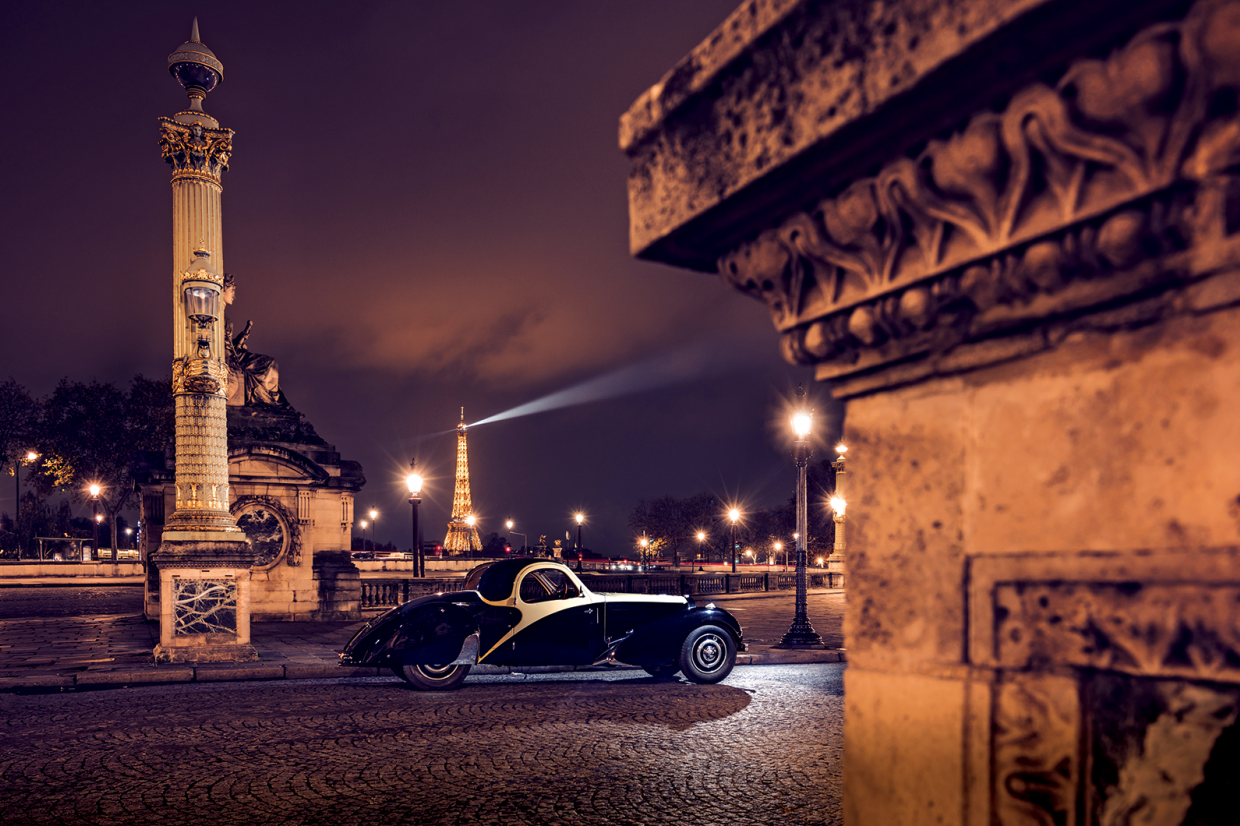 The fascinating history of this car, chassis 57432, was uncovered by Bugatti historian Pierre-Yves Laugier
The fascinating history of this car, chassis 57432, was uncovered by Bugatti historian Pierre-Yves Laugier
That effectively ended when his heart was broken by the death of his beloved son, Jean, while testing a Le Mans car in 1939.
Only 30 when he died, Jean had taken over the car-making side of the business in the early 1930s as Ettore became distracted by other projects.
Steeped in the culture of Molsheim from childhood, Jean was shaping up to be a more than able successor to his father in the field of automobile design.
This is perfectly demonstrated by the 1933-’40 Type 57, his rationalised – but certainly not compromised – concept of what a Bugatti road car should be.
 The Bugatti’s simple cabin has a nautical feel
The Bugatti’s simple cabin has a nautical feel
The 160bhp supercharged 57C and the fabulous low-chassis 57S and 57SC (200bhp, 120mph) are perhaps the most coveted of all ’30s sports cars.
But even the ‘cooking’ Type 57, built to the tune of 700 or more in its various iterations, is a chariot of the gods that would become the most successful Molsheim product since the T44.
It was powered by the double-overhead-cam, all-aluminium straight-eight that had been a Bugatti speciality since the Type 50.
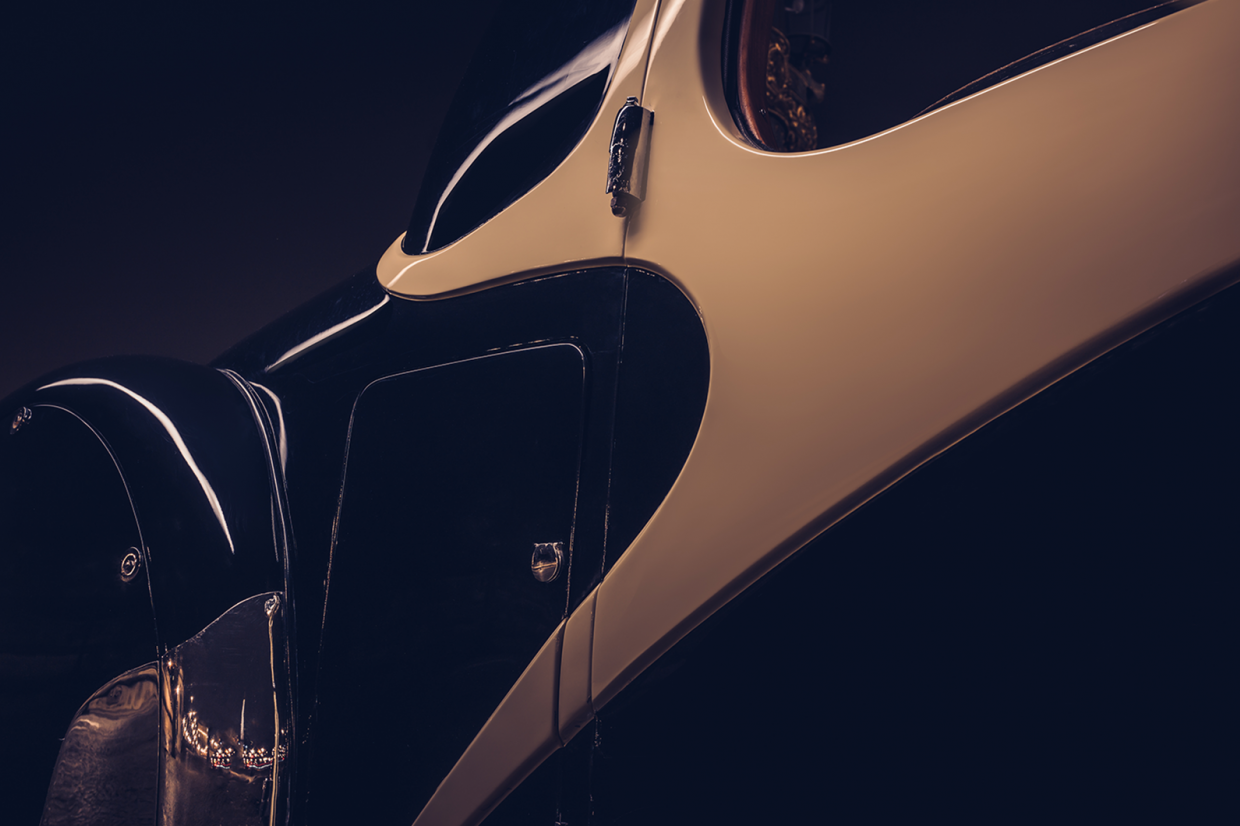 The exquisite shape of the Type 57 Atalante is full of drama
The exquisite shape of the Type 57 Atalante is full of drama
Smoother-running than its predecessors, it had no separate cylinder head but gained a wet sump and, at 3257cc, was larger than the short-lived Type 55’s and rated at 25.7 RAC horsepower.
Other improvements included a properly lubricated, one-piece billet crank; camshafts driven by spur gears; and a four-speed gearbox integral with the engine, with quiet constant mesh on all but first, plus a dry-plate clutch.
Underneath, the T57 was uncompromisingly ‘vintage’ with semi-elliptic springs on the front axle, trademark reversed quarter-elliptics at the rear and no fewer than 21 greasing points, many needing attention every 500 miles.
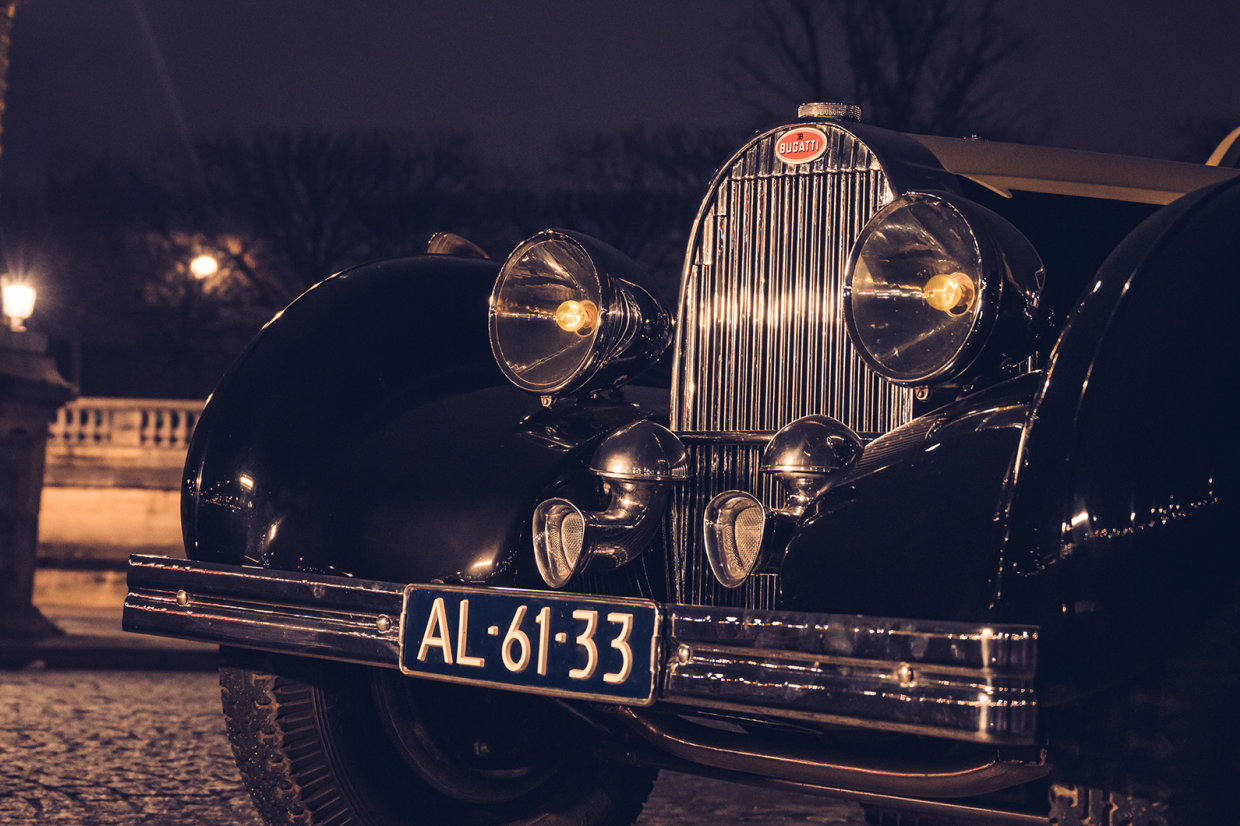 ‘Named for the fleet-footed Greek goddess, the Atalante was a grand touring car before the term had been coined’
‘Named for the fleet-footed Greek goddess, the Atalante was a grand touring car before the term had been coined’
Good weight distribution, and refinements such as a torque rod and anti-kick shackle on the front axle to some extent justified Bugatti’s continued faith in traditional suspension.
Jean proved the point by averaging 77mph in a Type 57 on a 435km run from the factory to Paris.
The brakes were mechanical at first, the engine solidly mounted, but Girling hydraulics and rubber mounts were adopted when the chassis was beefed up with cruciform sections.
Body styles were named after Alpine passes: the Ventoux Coach and Stelvio Cabriolet were by Gangloff, but the Galibier saloon was by the in-house carrossier that Jean had persuaded his father to establish.
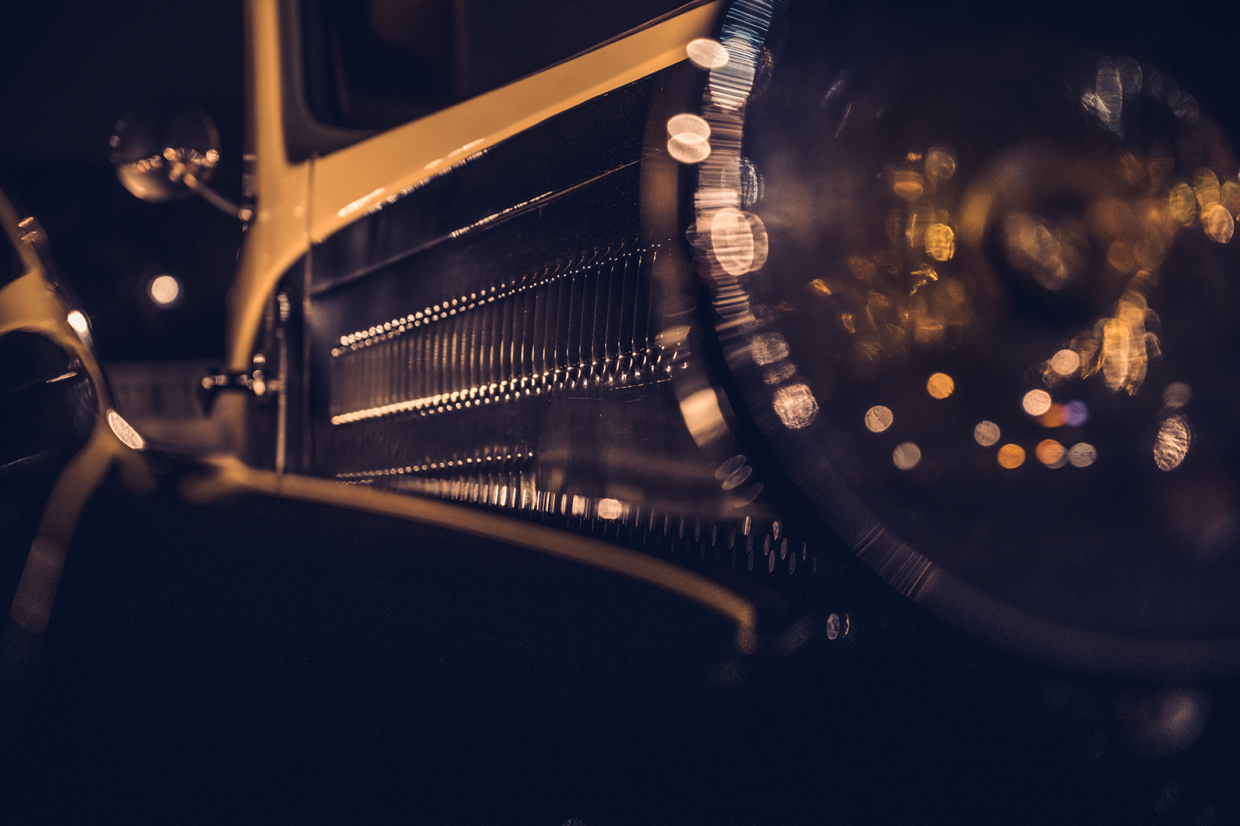 Louvres on the long bonnet help to cool the Bugatti’s spectacular straight-eight engine
Louvres on the long bonnet help to cool the Bugatti’s spectacular straight-eight engine
Offered from early 1935, the Atalante was the fourth member of the Type 57 family that was dominating production to the tune of four to eight examples per week.
Factory design number 1070 was called the Faux Cabriolet when revealed in April ’35, and didn’t acquire the Atalante name until its Paris Salon outing in October.
Not to be confused with the fabulous, four-off T57 Atlantic with its riveted, dorsal-finned body, the Atalante was named for a fleet-footed Greek goddess and was a more customer-friendly approach to the idea of a luxury, high-performance two-seater.
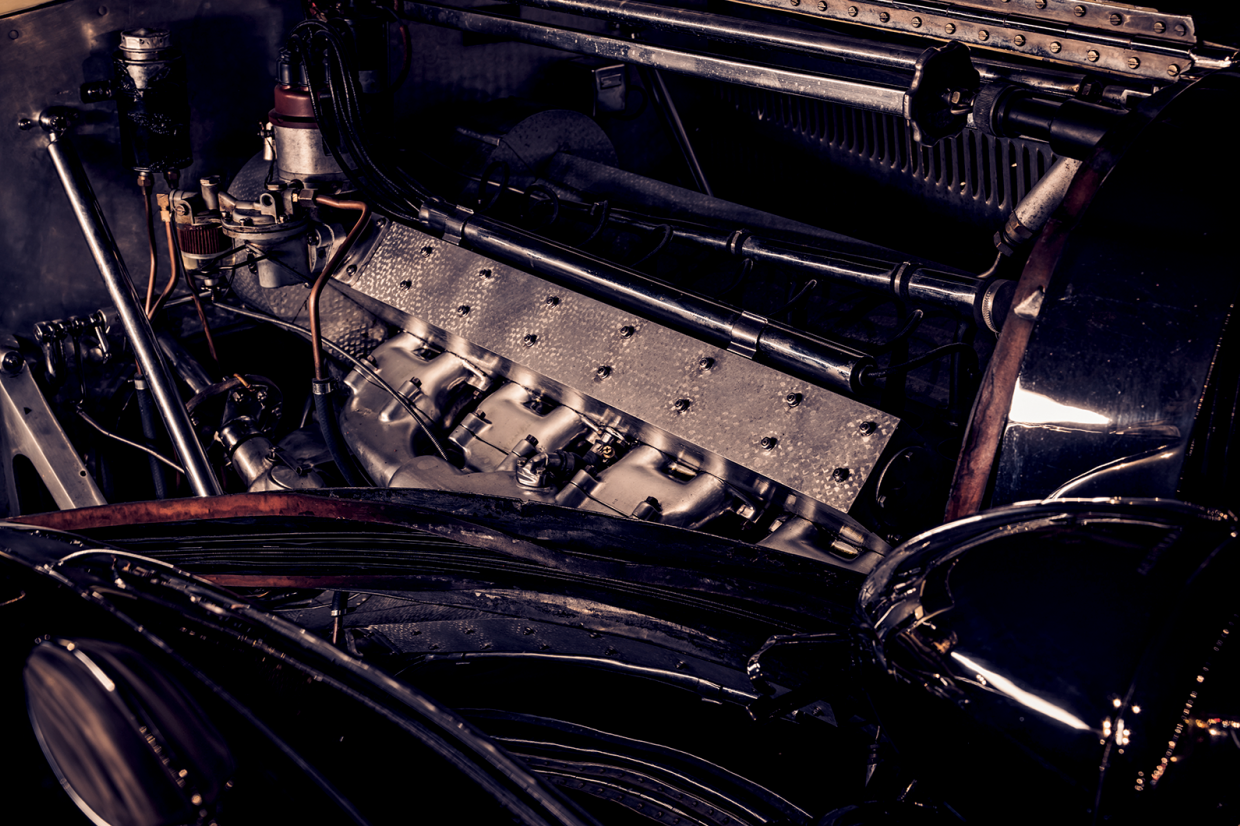 Bugatti’s familiar twin-cam straight-eight was fitted with a wet sump for the Type 57
Bugatti’s familiar twin-cam straight-eight was fitted with a wet sump for the Type 57
This was a grand touring car before the term had been coined, on a 10ft 10½in wheelbase with aluminium coachwork by Jean and his leading draughtsman, Joseph Walter.
Usually finished in two-tone schemes, Atalantes had flat, one-piece ’screens, full-sized doors with teardrop windows and a long, sweeping tail.
Of the 10 Atalantes built in the first year and priced at Ffr90,000, seven had sunroofs using a patented system that encompassed the entire roof and was called variously Toit Ouvrant, Coupé Découvrable or Bureau Rolltop, the latter an accurate allusion to the way the fabric disappeared into the rear of the body.
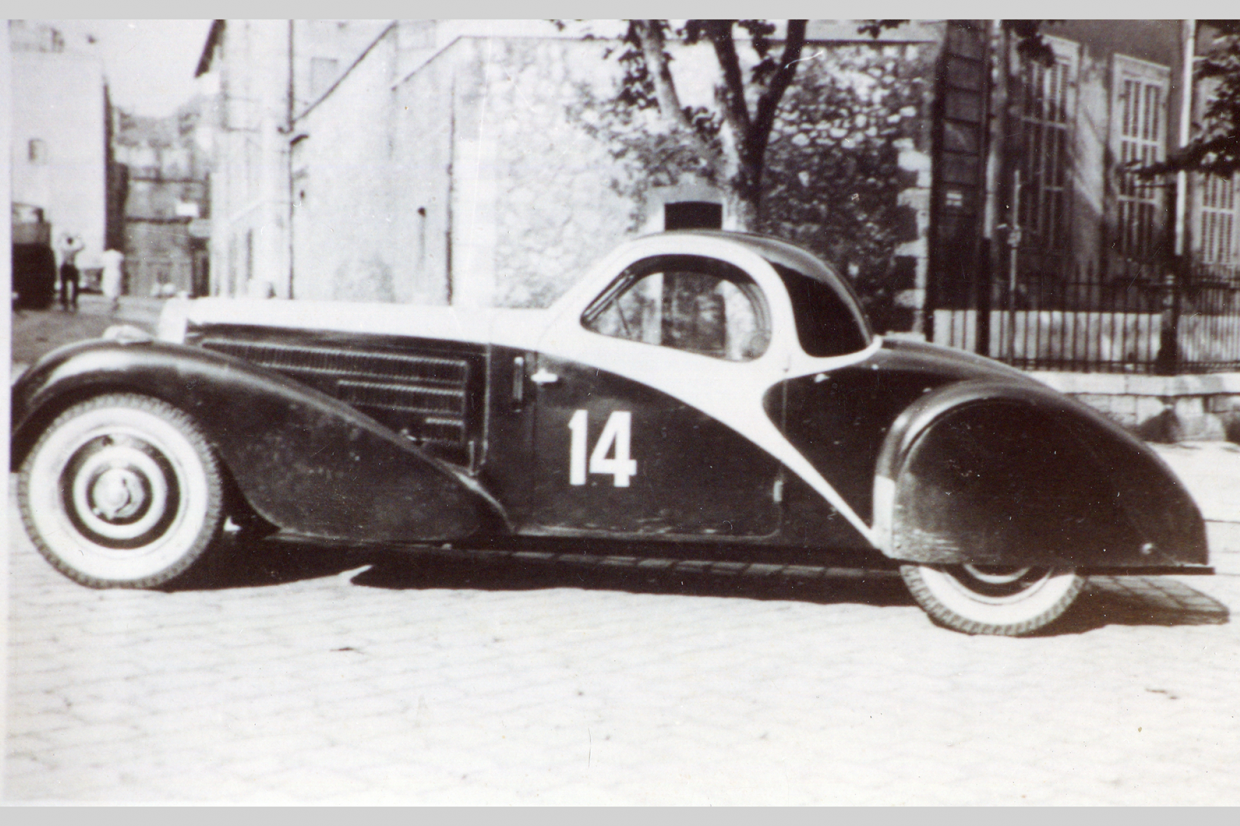 The Bugatti was delivered new to French jeweller Charles Joseph Olivero © Archives Pierre-Yves Laugier
The Bugatti was delivered new to French jeweller Charles Joseph Olivero © Archives Pierre-Yves Laugier
The model was withdrawn after the 1938 Paris Salon, with 36 built, and of the 10 sunroof cars only three – chassis 330, 401 and 432 – still wear their original bodywork.
This one, chassis 57432 (engine number 315, body 17), left the Bugatti coachbuilder on 13 July 1936 and is described in one of the surviving factory logs as ‘Coupé Atalante 57432/315, black and ivory, tan leather’.
It was ordered by the Bugatti agent in Marseille, Gaston Descollas, for his customer Charles Joseph Olivero, a local jeweller and Bugatti enthusiast who sold a Type 49 Cabriolet to fund the Atalante.
It was registered new on 24 July 1936, with the number 8357 CA 8.
 Chassis 57432 prepares to take part in the 1938 Rallye des Alpes © Archives Pierre-Yves Laugier
Chassis 57432 prepares to take part in the 1938 Rallye des Alpes © Archives Pierre-Yves Laugier
In July 1938, Olivero took part in the Rallye des Alpes, but had to retire on the stage from Chamonix to Nice.
The jeweller was married, yet usually took his brother or a girl called Daisy with him to navigate rather than his wife, who had no interest in rallying.
Mme Olivero said she was not worried by the arrangement because the lady had “no female attributes”.
The following year Charles ordered a T57C Gangloff Roadster, driving the Atalante from Marseille to Colmar every Friday evening to monitor progress.
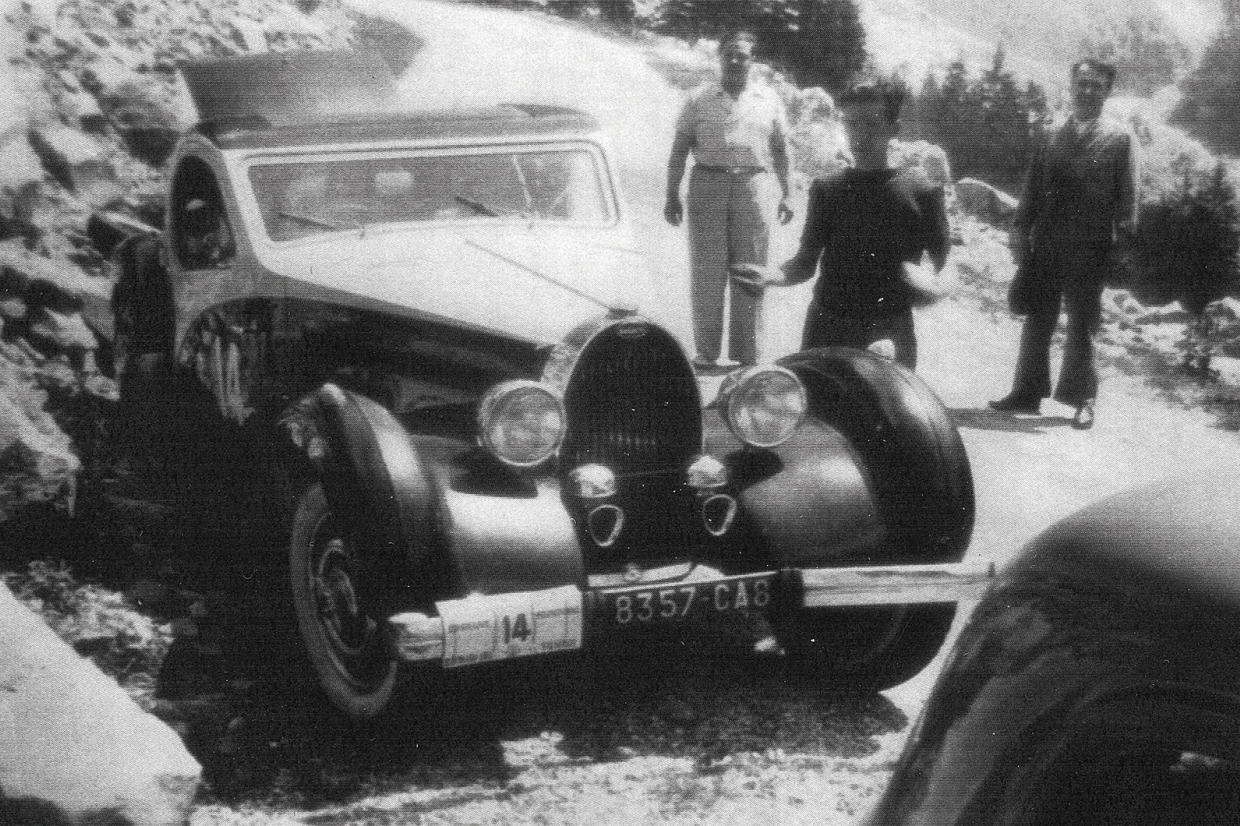 Olivero and his Type 57 Atalante were forced to retire from the 1938 Rallye des Alpes © Archives Pierre-Yves Laugier
Olivero and his Type 57 Atalante were forced to retire from the 1938 Rallye des Alpes © Archives Pierre-Yves Laugier
When his new car was ready, the Atalante is thought to have been sold to a mechanic from Nîmes, Émile Reveiller, but was quickly moved on to WW1 fighter ace and pioneer commercial aviator Léon Givon, who was the chief pilot for Air France at the time and later received the Légion d’Honneur for his service in the French Resistance.
A keen rally driver, Givon took part in the Rallye des Alpes Française from 13-17 July 1939, but does not appear in the list of finishers.
He re-registered the Bugatti 7262 CB 1 at his villa near Marseille on 25 August 1939, just a week before the start of WW2, and used it as his everyday car.
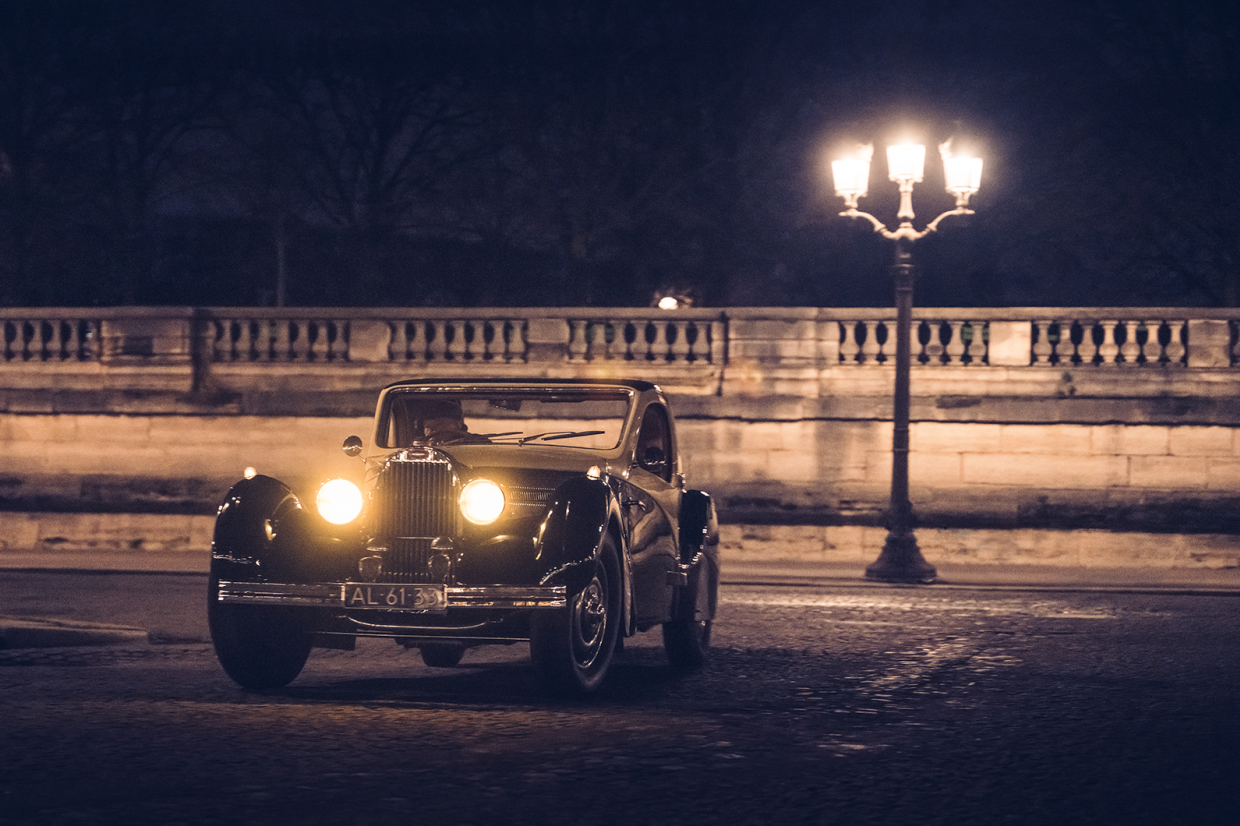 ‘These were complex but beautifully wrought vehicles for very wealthy people who took their driving very seriously’
‘These were complex but beautifully wrought vehicles for very wealthy people who took their driving very seriously’
Trace of the Atalante was lost during the war, but it re-emerged in Luxembourg in 1948 with industrialist Rudi Cloos.
It still had its original engine, but Cloos decided on a full rebuild that included replacing the motor with one from an ‘orphan’ T57 rolling chassis that had been sold out of Molsheim just before hostilities began.
Between June 1948 and April ’49 the Atalante was with coachbuilder Jos Metz then Garage Loll Lambert, in Luxembourg, for a metal coupé body with a Ventoux ’screen and low-set, faired-in headlights.
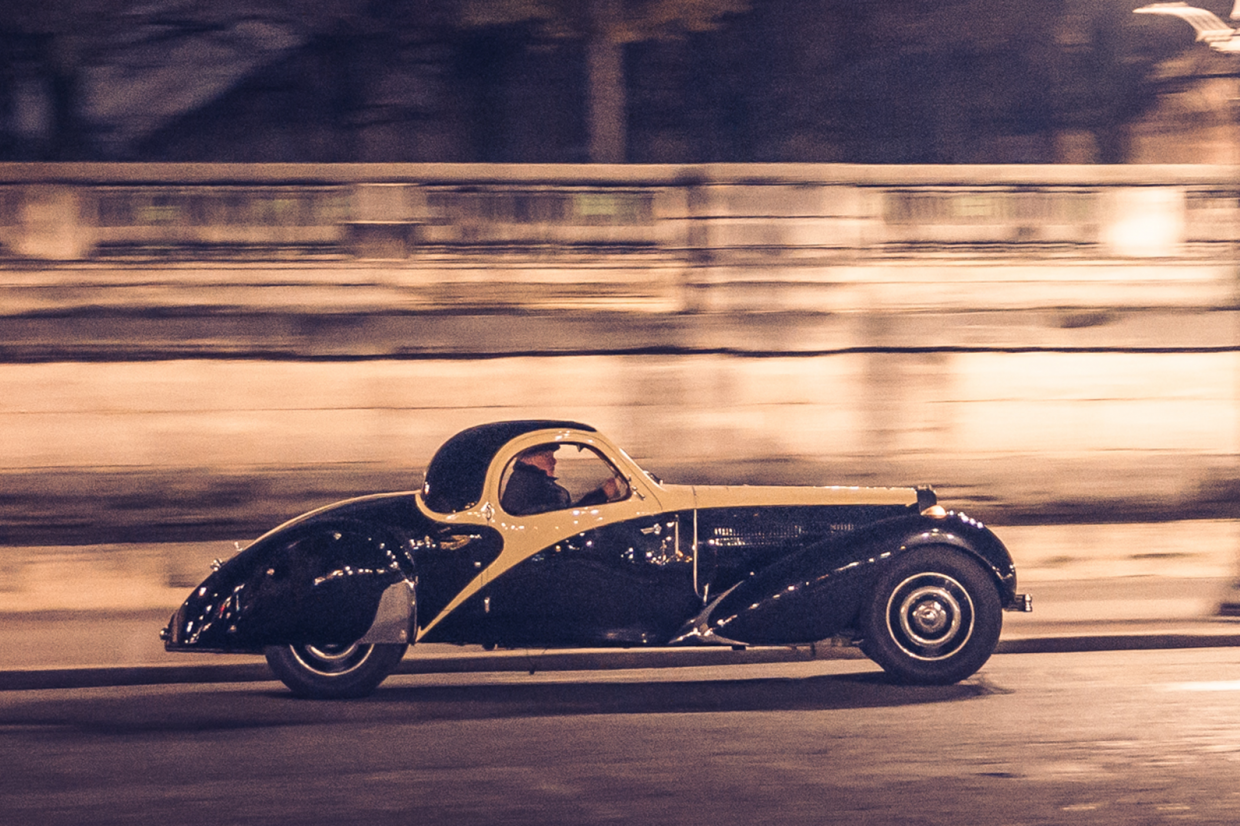 The original two-tone paint scheme accentuates the curvaceous lines of Jean Bugatti’s masterpiece
The original two-tone paint scheme accentuates the curvaceous lines of Jean Bugatti’s masterpiece
A new, unnumbered transmission was fitted, and gearbox 315 was left on the new chassis – without engine 547 – which was then clothed with a Ventoux body.
The Atalante was used on the road by Cloos, who appears to have played pretty fast and loose with vehicle identities.
Wearing the registration L 5289, and with its documents showing the number of its new engine (547), the former chassis 57432 became, erroneously, 57547.
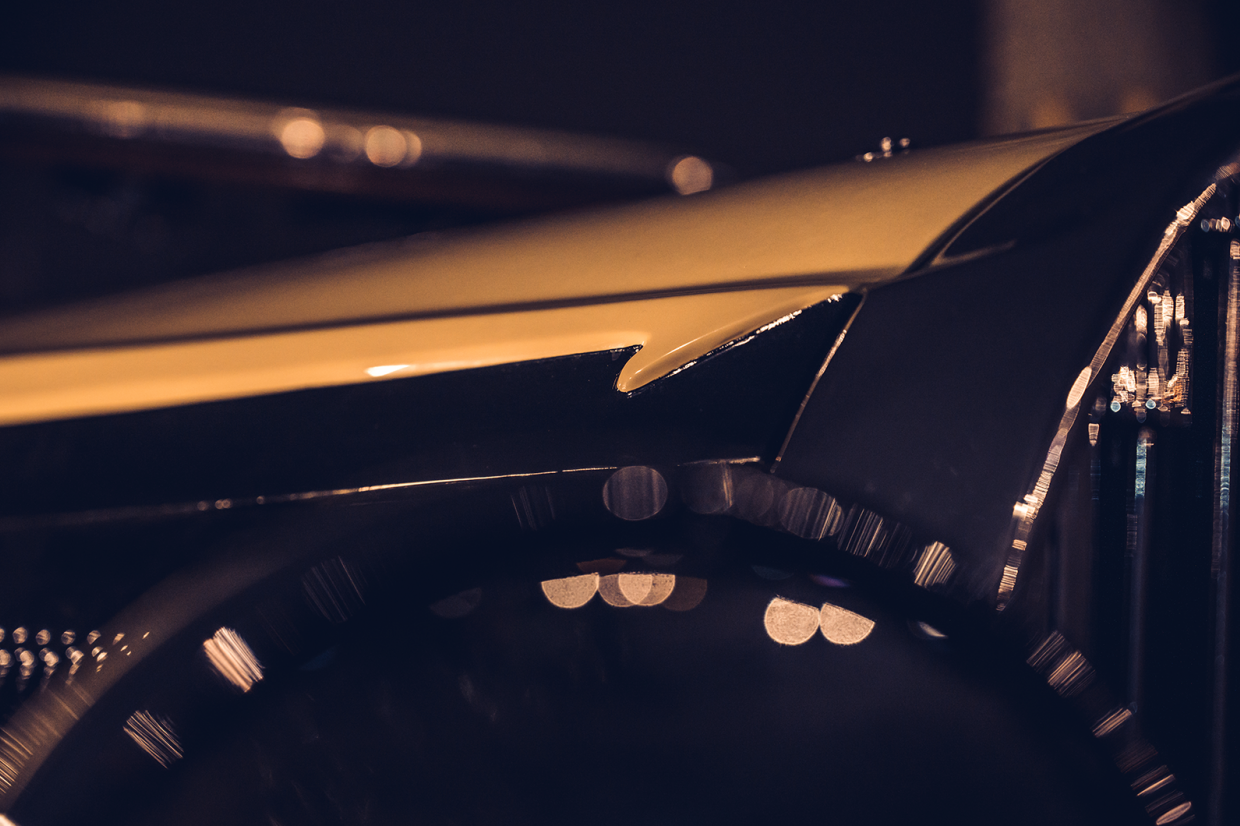 Cannes-based collector Bernard Mérian returned the Bugatti Type 57 Atalante to its original colour scheme
Cannes-based collector Bernard Mérian returned the Bugatti Type 57 Atalante to its original colour scheme
The true T57 chassis 547 is a very original ’37 Ventoux with no ties to this Atalante, which decades later became 57432 once again after engine number 547 was erased and re-engraved 315.
This, of course, was for historians to uncover: 70 years ago, nobody much cared.
Cloos sold the Atalante in November 1950 to Belgian architect Albert Jean de Lay, who took it with him to a job in the Belgian Congo.
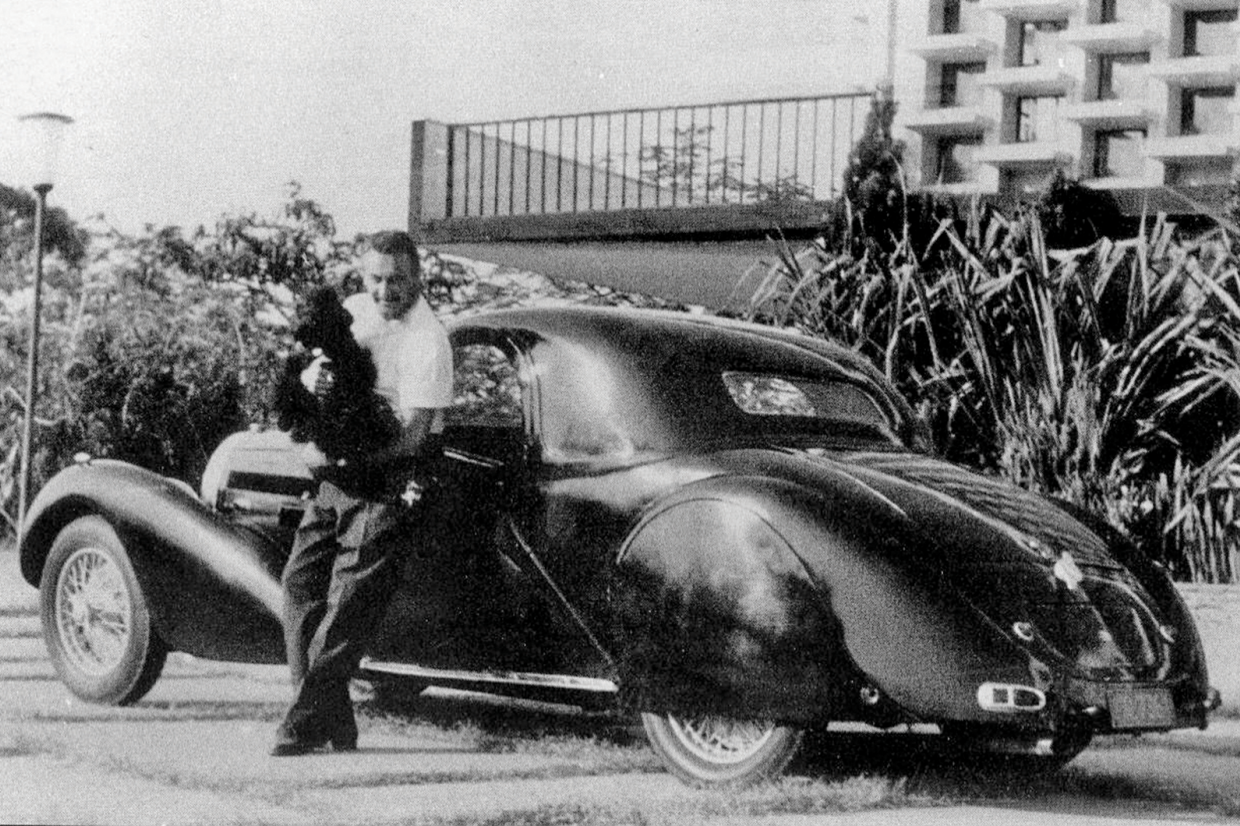 The Bugatti Type 57 Atalante with its fifth owner, Albert Jean de Lay, in the Congo © Archives Pierre-Yves Laugier
The Bugatti Type 57 Atalante with its fifth owner, Albert Jean de Lay, in the Congo © Archives Pierre-Yves Laugier
It was maintained locally in Elisabethville, but a starting problem proved difficult to trace.
Even returning the car to the factory failed to cure the issue, which remained as civil war erupted in the recently independent African state in 1963.
Luckily, however, as angry locals began advancing on the expat’s home, the usually sulky Bugatti started first time, allowing the de Lays to flee for their lives to Zambia at 90mph.
 The Bugatti’s relatively plain dashboard features just a few dials and switches
The Bugatti’s relatively plain dashboard features just a few dials and switches
The architect and his wife returned penniless to Belgium, where Cloos agreed to take back the Atalante.
He was issued the local number L 4005 and owned the car for a decade, until another colourful character entered the T57’s life.
Gaston Greven owned the Royal Bugatti nightclub, which was regularly patronised by Cloos.
Greven had just taken delivery of a new Jaguar XJ12, for which there was a year-long waiting list, and Cloos was impressed enough to offer a swap with the Atalante plus a cash adjustment in Greven’s favour.
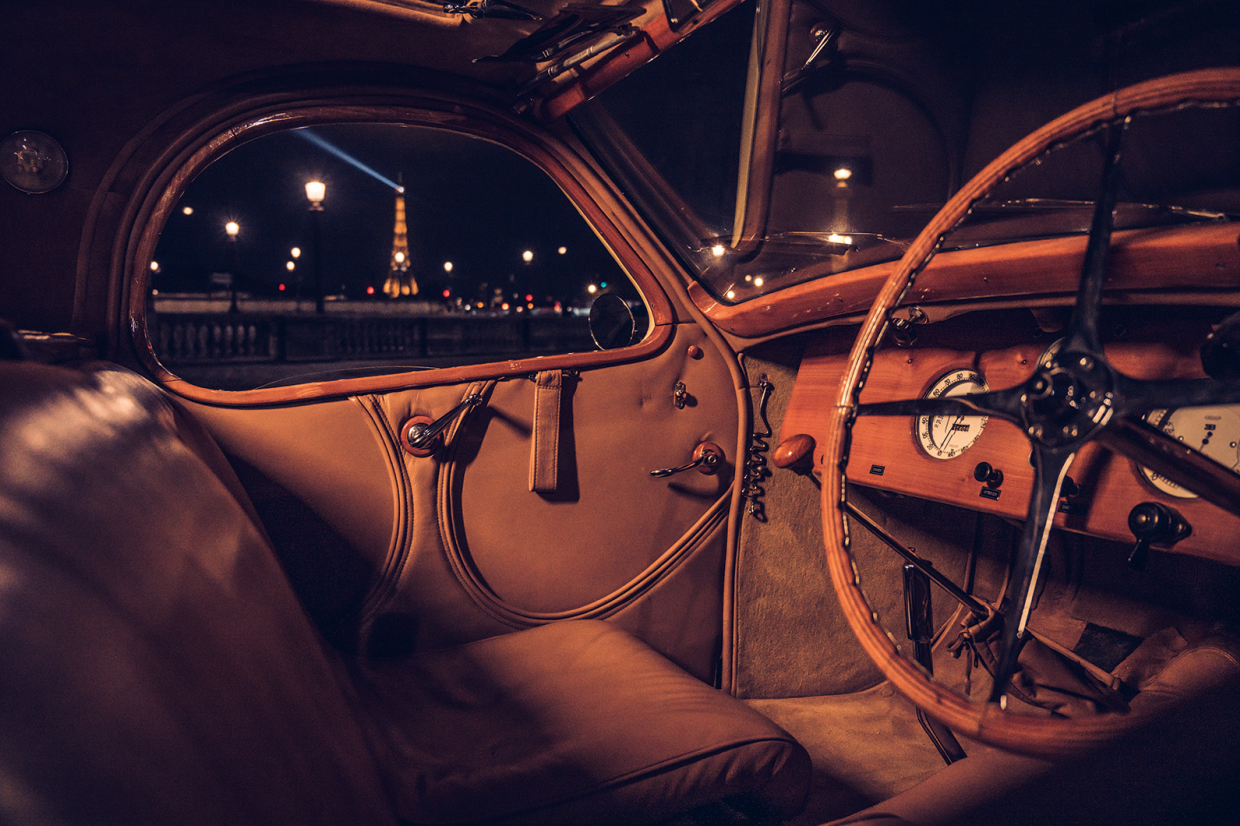 Art Deco-style map pockets in the doors mirror the classic Bugatti’s curves
Art Deco-style map pockets in the doors mirror the classic Bugatti’s curves
After repainting the car yellow and dark blue, Greven took part in the 1974 Rallye Monte-Carlo des Voitures Anciennes, keeping the registration L 4005.
On another event Greven met Lucien Mette, who asked what figure would part him from the Type 57.
Greven came up with a number that should have put him off; it didn’t, and he felt compelled to sell the Atalante when Mette turned up at his hotel the following day with a suitcase full of cash and two large associates.
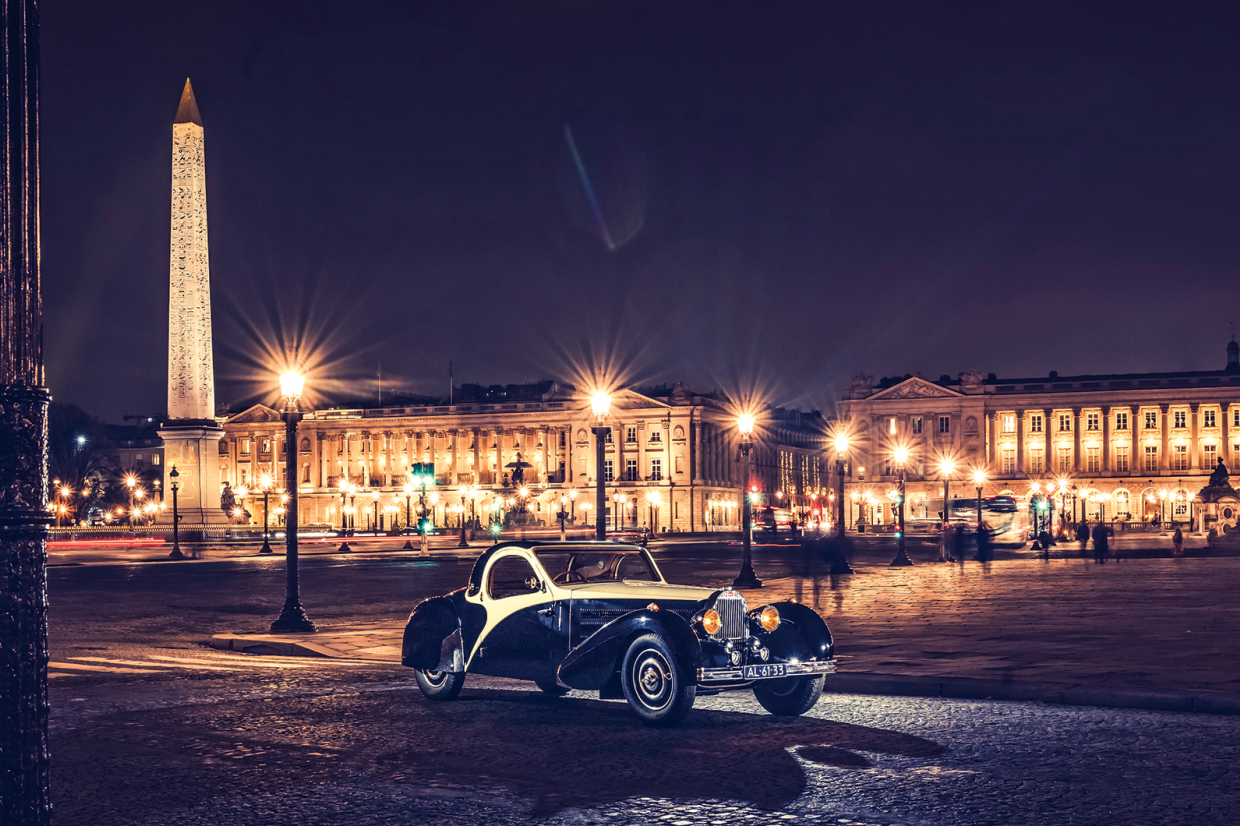 Atalantes are distinguishable by their flat, one-piece windscreens and full-sized doors with teardrop windows plus a long, sweeping tail
Atalantes are distinguishable by their flat, one-piece windscreens and full-sized doors with teardrop windows plus a long, sweeping tail
Mette was actually sourcing cars for collector Maurice Teisserenc, who became the car’s new keeper in September 1974.
By that stage the Atalante needed a major mechanical overhaul, including repairs to a bent front axle.
Colin Crabbe’s UK-based Antique Automobiles did the work, modifying the roof back to something approximating the original style and repainting it black and red.
Teisserenc used the Atalante in ’78 for the Bugatti 100 in Deauville, plus various other rallies, and kept it for another decade.
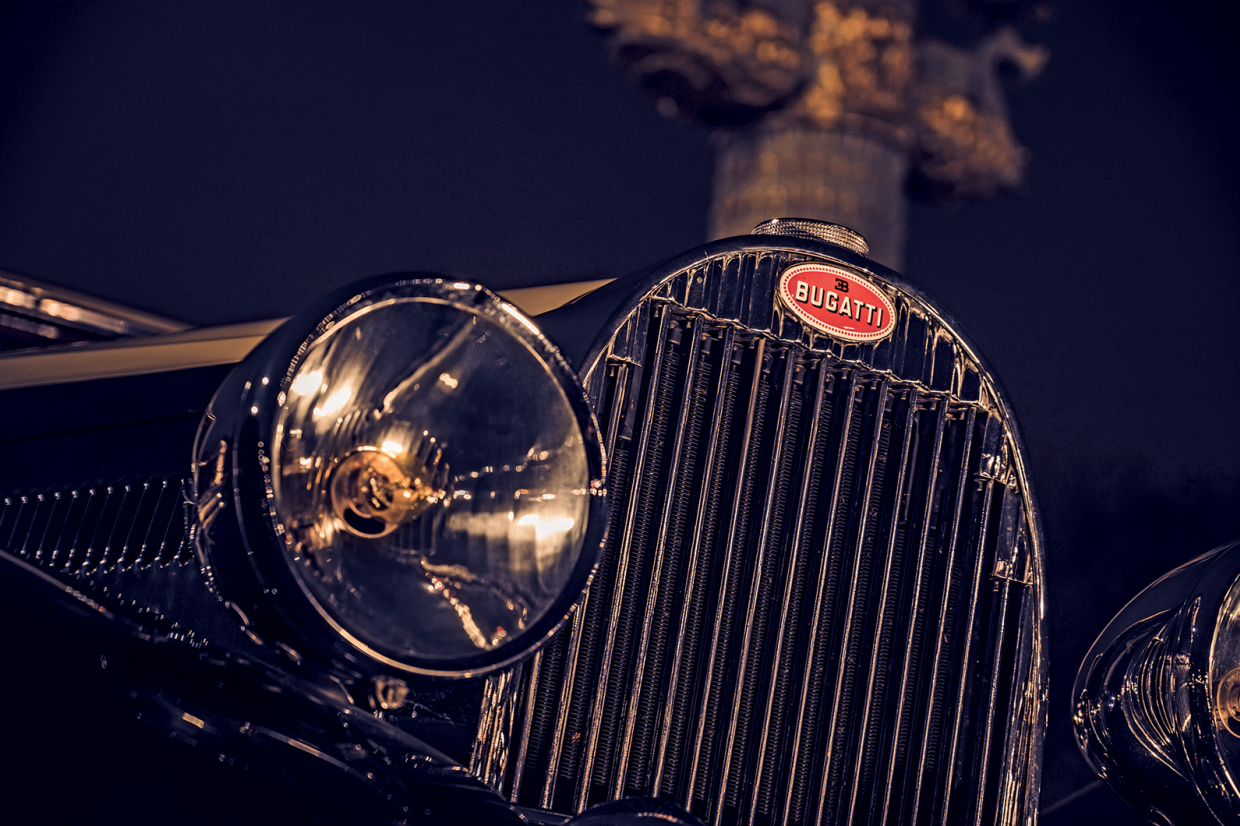 A signature horseshoe grille fronts the Bugatti’s long bonnet
A signature horseshoe grille fronts the Bugatti’s long bonnet
At auction in Fontainebleau in May 1988, the Atalante was bought by Cannes-based collector Bernard Mérian, who had the means to finally restore the Atalante to factory configuration.
With the help of Bugatti historian Pierre-Yves Laugier, the car’s true identity was uncovered: luckily the rear axle still had ‘315’ engraved on it, and Laugier was able to link this information back to the original chassis number.
He even spoke to Olivero, who recounted the story of the car’s early years and handed over photos that enabled Jean-Claude Tisserand to restore the bodywork and create an exact copy of the sunroof.
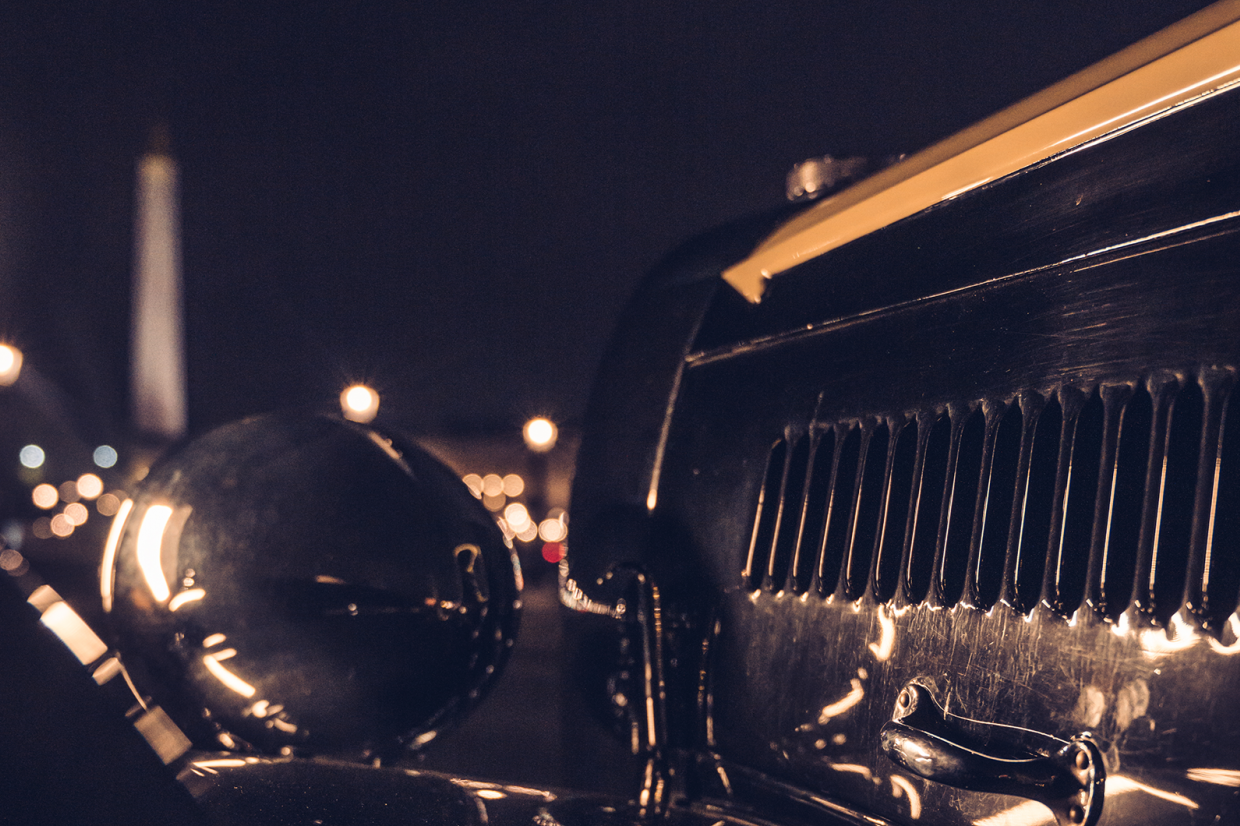 The headlights shine a warm glow over Paris’ cobbled streets
The headlights shine a warm glow over Paris’ cobbled streets
M Pallier of Tours rebuilt the engine, while the chassis, running gear and electrics were overhauled by Claude Afchain of Houdan.
Once completed, in 1992, the Atalante was reunited with Olivero’s widow and daughters, then put on display at the Musée National de l’Automobile.
It was also shown at Rétromobile in 1995 before being sold at an auction at the Nürburgring in 2001.
The new keeper, Dutch entrepreneur Victor Muller, took it to Pebble Beach, Goodwood and Villa d’Este before current owner Kees Jansen bought the Atalante at the Concours d’Élégance Palais Het Loo sale in 2003.
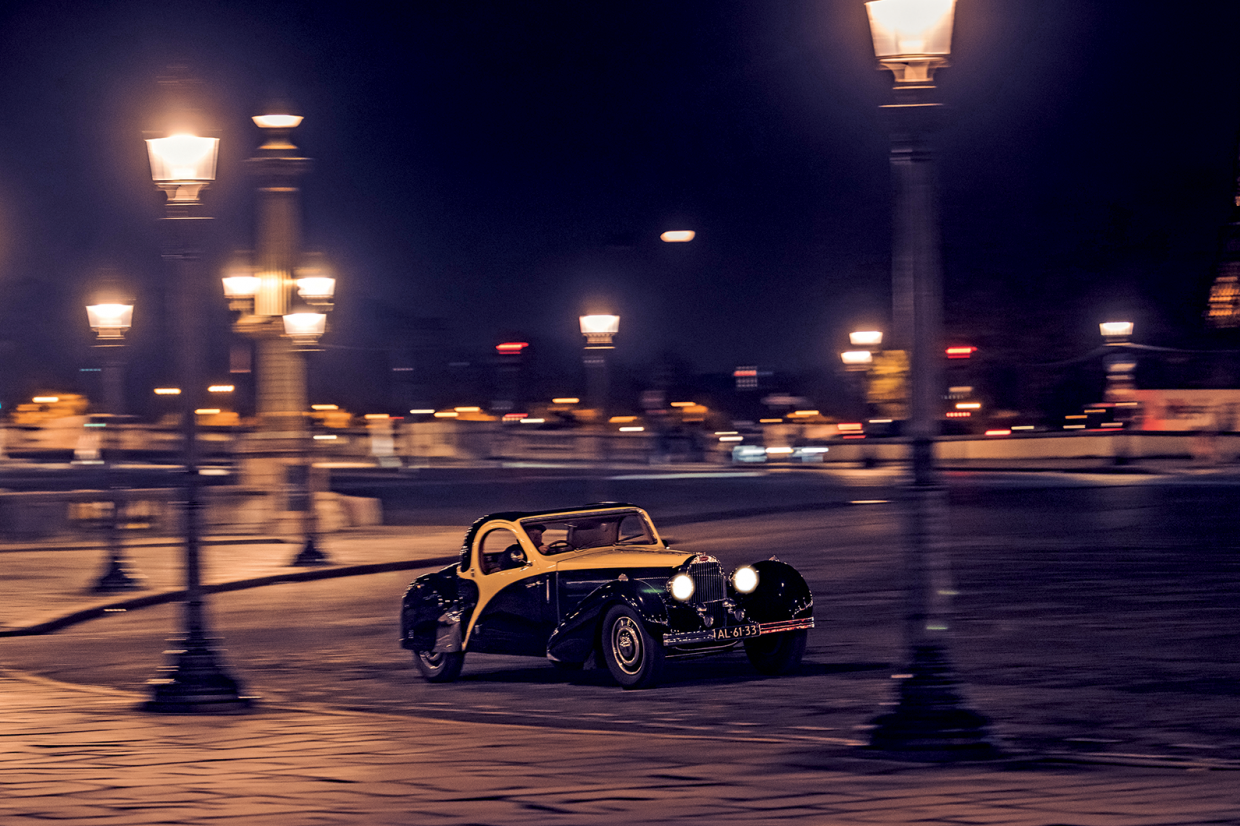 This classic Bugatti Type 57 Atalante is refined for its age
This classic Bugatti Type 57 Atalante is refined for its age
He has enjoyed the many and varied high-end events that T57 ownership makes possible, and a local specialist finally got to the bottom of the starting problems (suppressors on the plug leads, fitted in the 1950s) and added the not strictly correct T57SC six-pipe exhaust in the name of gas flow and clearance.
Weirdly, my Bugatti education began – and ended – with a hugely compromised drive in the ex-Briggs Cunningham Royale 20 years ago, so my encounter with the far more manageable Type 57 was keenly anticipated.
On a cold Paris evening its aura attracts passers-by, most of whom seem to know what they are looking at.
Those who don’t still recognise the authority of the big, nickel-plated Marchal Aerolux lamps and the elegance of the rounded tail.
 Bugatti’s quest for perfection extends to the finest details
Bugatti’s quest for perfection extends to the finest details
Even the exposed, nickel-plated front axle is a visual delight, and you could hardly mistake that symmetrical sculpture of an engine, with every part finished like a piece of mechanical jewellery, for anything other than a Bugatti.
It looks so sanitary yet so full of drama, you can’t imagine it ever leaking oil or overheating.
It’s so tidy that even the carburettor is hidden from view under the polished inlet manifold.
The exposed door hinges grate slightly and the boot, which should be huge, is mostly full of spare wheel, but there is a separate locker for the tools and a small hatch behind the driver’s door to give access to the covered space behind the seats, plus giant Art Deco-style map pockets in the doors.
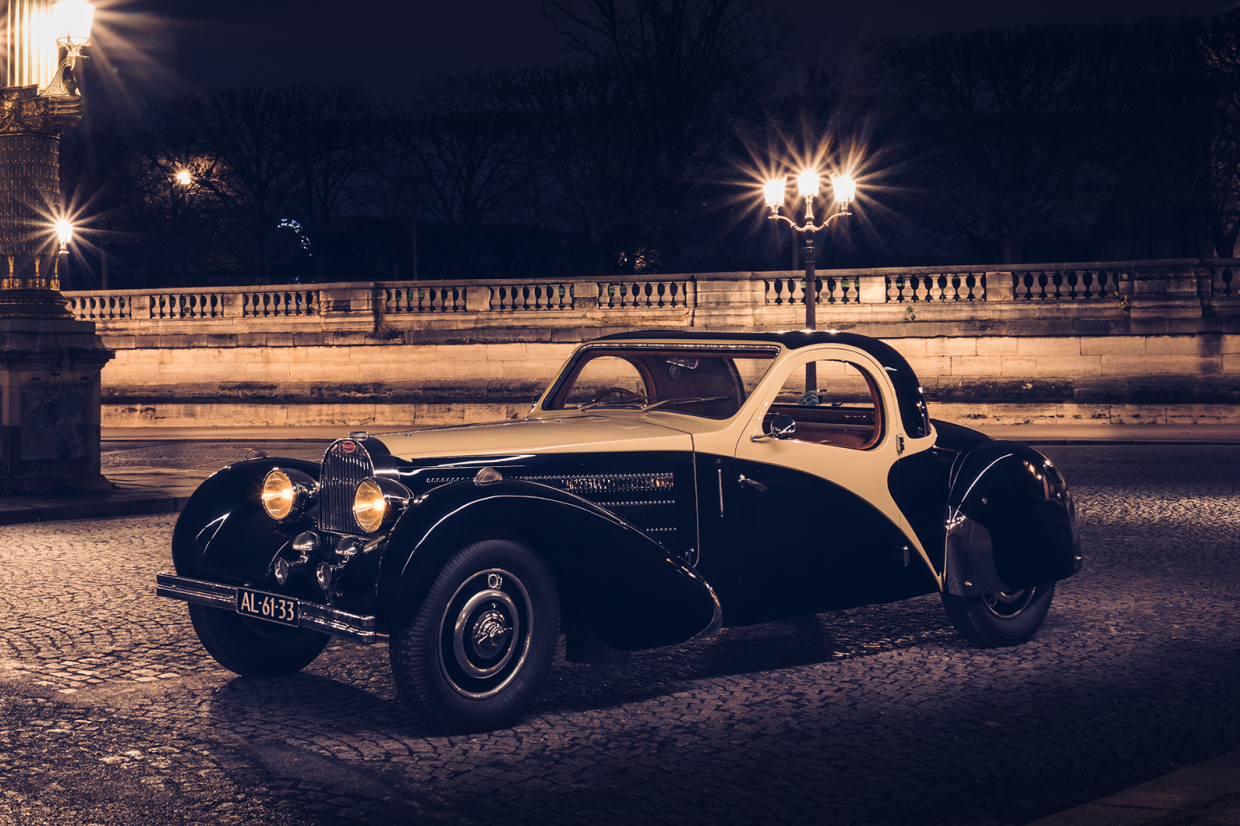 Eight Type 57 Atalantes were built in 1936, just three of them with the distinctive roll-top roof worn by chassis 57432
Eight Type 57 Atalantes were built in 1936, just three of them with the distinctive roll-top roof worn by chassis 57432
The cosy cabin has a nautical feel somehow, with finely calibrated cream-faced instruments that are beautifully backlit.
To the right of the large four-spoke wheel, on its long, slender shaft, are two chrome fingers to control the fast idle and the ignition advance/retard.
The tubular-framed seats look inviting but are fixed and not much fun for our 6ft-plus host, Pierre Novikoff from auctioneer Artcurial, whose head almost sticks out above the line of the roof as he struggles to work the clutch with his knees jammed under the dashboard.
I now understand why the 6ft 7in-tall Victor Muller parted with the Atalante: he just didn’t fit.
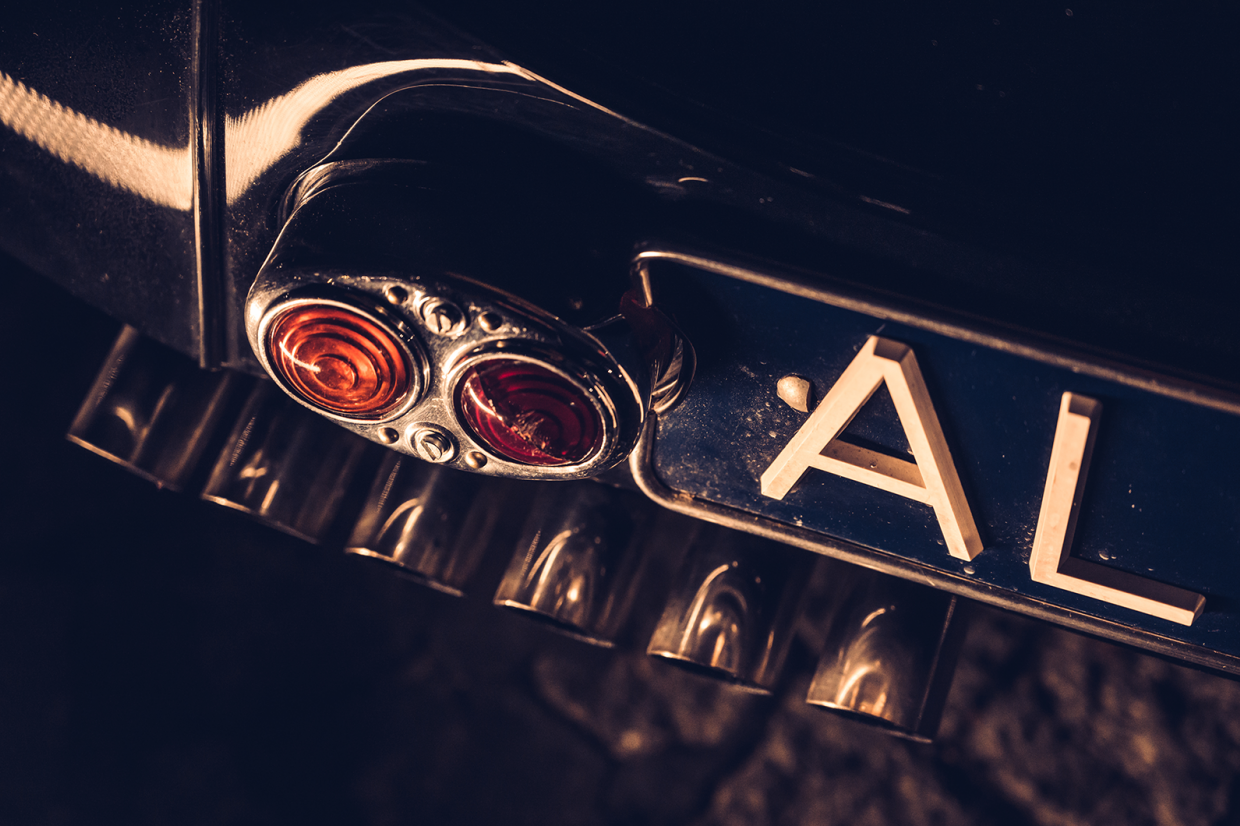 A six-pipe exhaust from a T57SC was fitted to improve gas flow
A six-pipe exhaust from a T57SC was fitted to improve gas flow
Luckily, I do. Once I’ve disentangled my feet from the A-pillar on climbing aboard, I’m comfortable.
On a night such as this I could live without the joys of the ‘Bureau’ roof, but it does give good rear vision for avoiding the cyclists who dart out of nowhere on dark Paris streets.
To start from cold you fully advance the ignition, apply some choke, and turn the key. With a good battery (it lives under the driver’s seat), the straight-eight should fire immediately.
After a few minutes’ warming you can retard the timing and start taking off the choke.
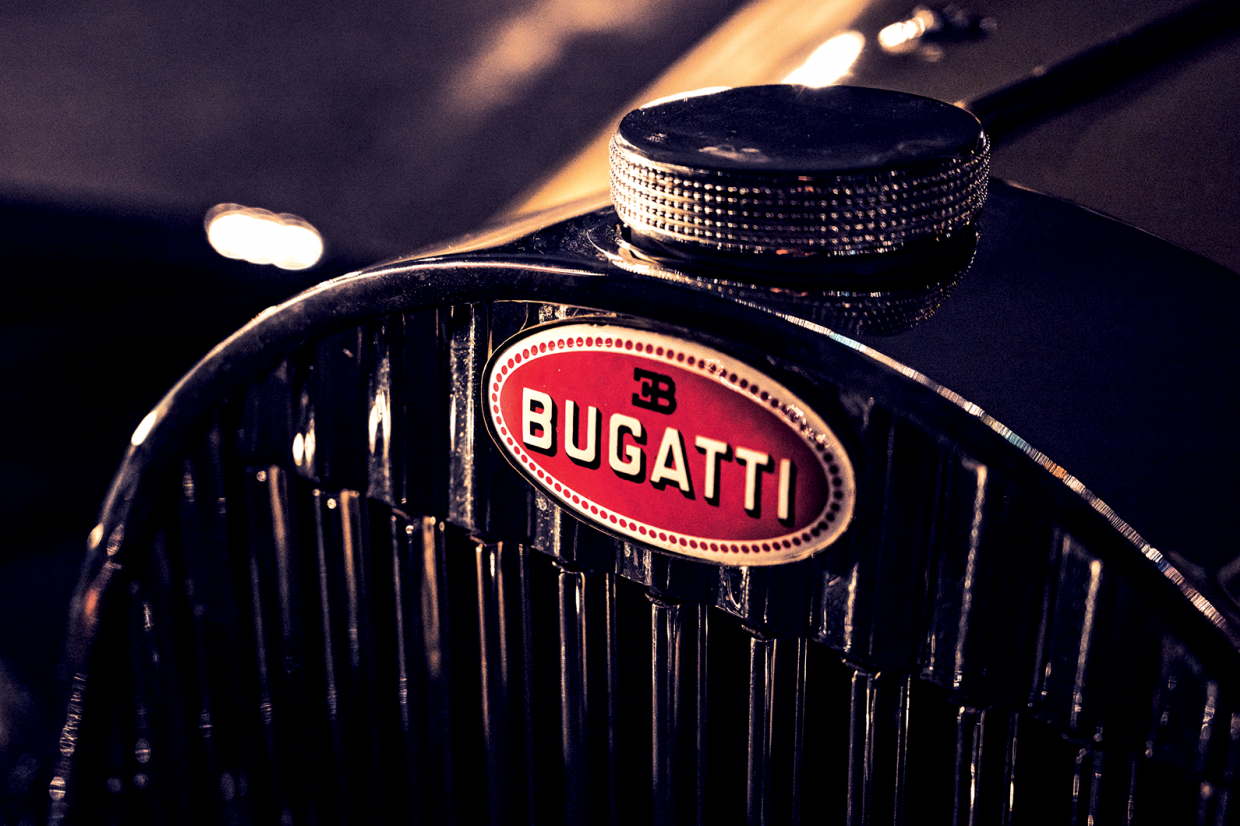 Ettore and Jean Bugatti created some of the earliest exotic cars
Ettore and Jean Bugatti created some of the earliest exotic cars
The engine is smoother and quieter than expected, and very responsive and flexible, with a gravelly burble from the exhausts.
Acceleration considered sparkling 80 years ago is still usefully lively, with a smooth and swift build-up of revs that must have fascinated anybody used to a sidevalve saloon: most ’30s family cars could hardly manage in top what the Type 57 does in second.
On 3.3 litres and 140bhp at 4800rpm, this 2010lb two-seater would crack 52mph in second, 77mph in third and 95mph flat-out.
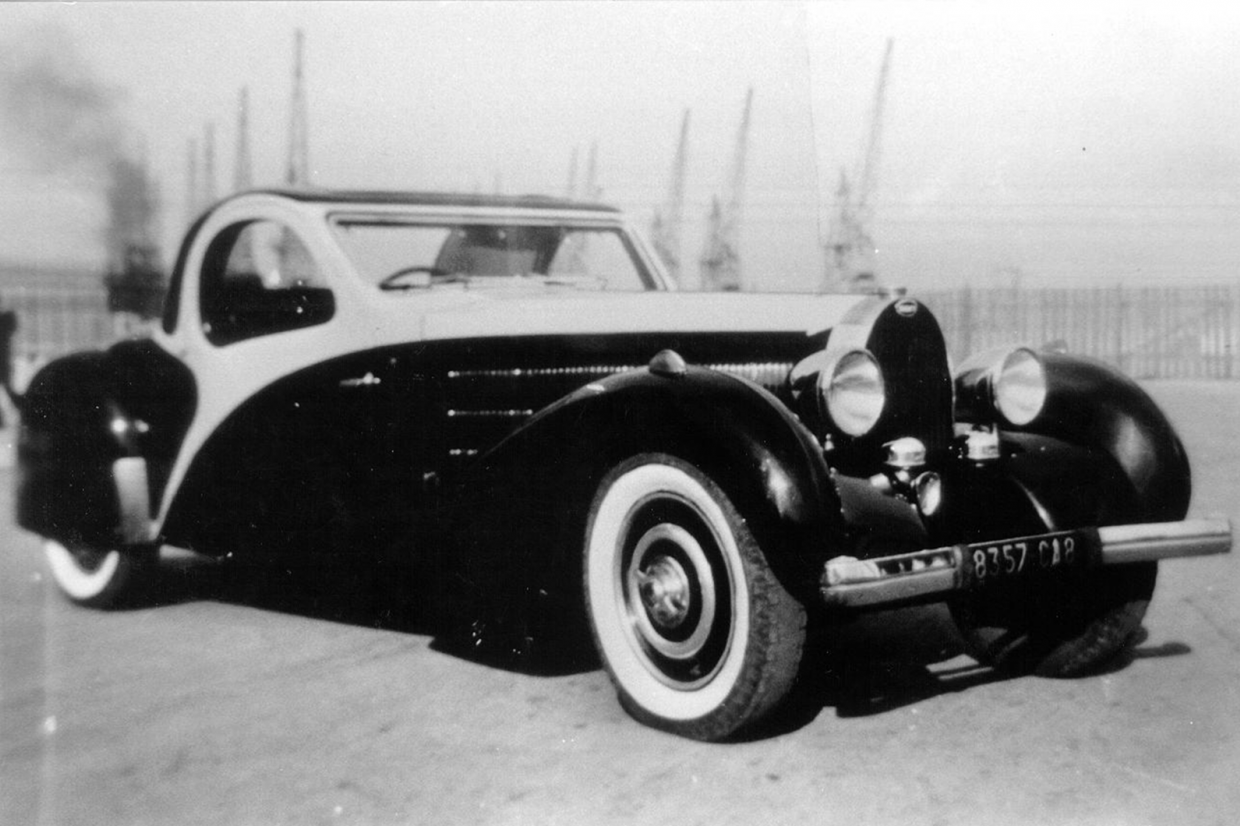 Chassis 57432 on the harbour of Marseille, shortly before it was delivered to its first owner © Archives Pierre-Yves Laugier
Chassis 57432 on the harbour of Marseille, shortly before it was delivered to its first owner © Archives Pierre-Yves Laugier
First gear is noisy, the rest quiet; the clutch is as light as a modern car’s, and you only need to double-declutch coming down from third to second (in which you can happily pull away).
It is not a time machine, however, and certain allowances need to be made.
This Atalante was one of the first to have hydraulic brakes, but they won’t stand the car on its nose or pull it up in a particularly straight line.
Generally, though, the Bugatti is refined, with few rattles from the body and confident, direct steering that only becomes heavy in tight-radius turns tackled faster than it really wants to go.
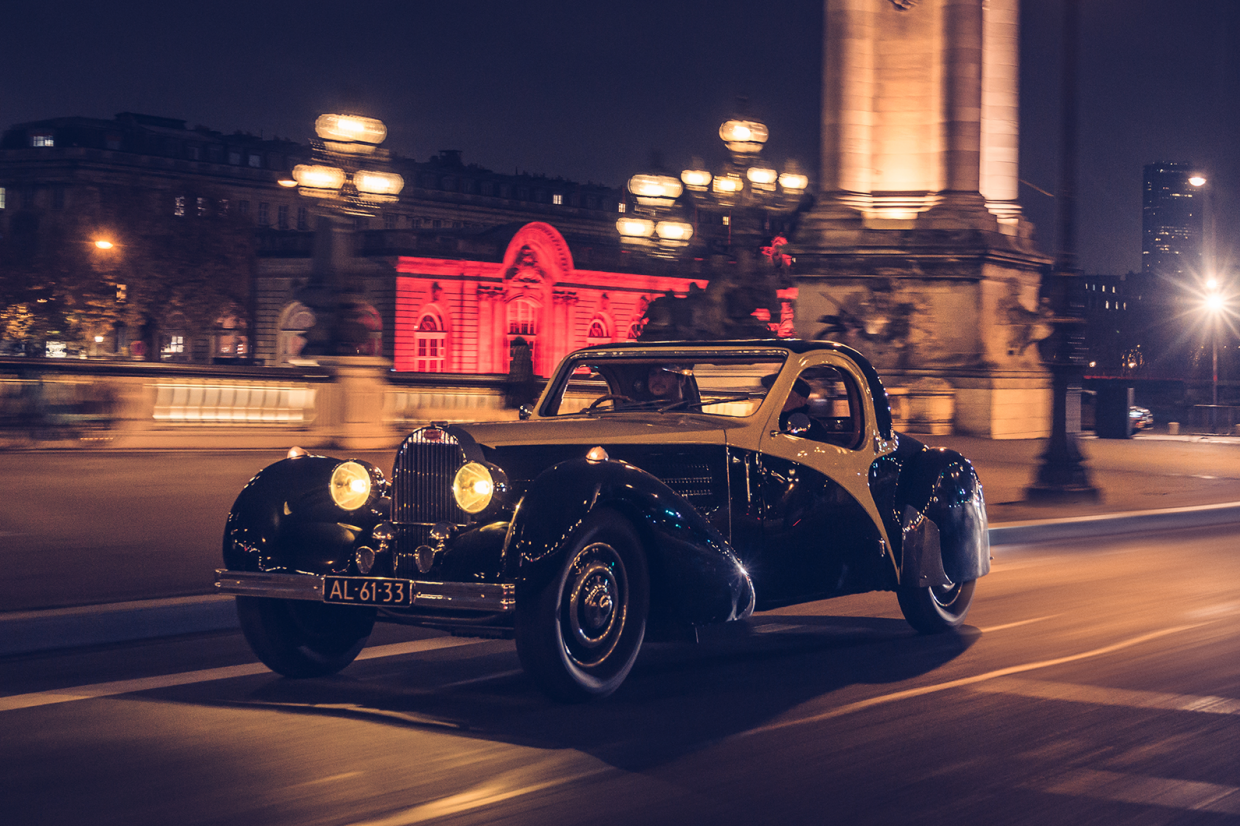 Any drive in a classic Bugatti is a rare treat to be treasured
Any drive in a classic Bugatti is a rare treat to be treasured
A general air of superiority pervades as it traverses the thoroughfares of wintry Paris, sublime front wings quivering gently over the cobbles, headlights emitting little more than a yellow glow. The exquisite tension between art and engineering Ettore fostered in his creations is probably still unique.
Obviously far more than just means of transport, it might be true to say that the Bugattis – father and son – built the first truly ‘exotic’ automobiles, in a technical language that was theirs alone.
These were complex but always beautifully wrought objects, built for very wealthy people who took their motoring very seriously and, like Mr Bugatti, viewed a motor car not as an inanimate object, but a product of careful breeding into which a highly strung facility for speed and responsiveness was baked into the very bones.
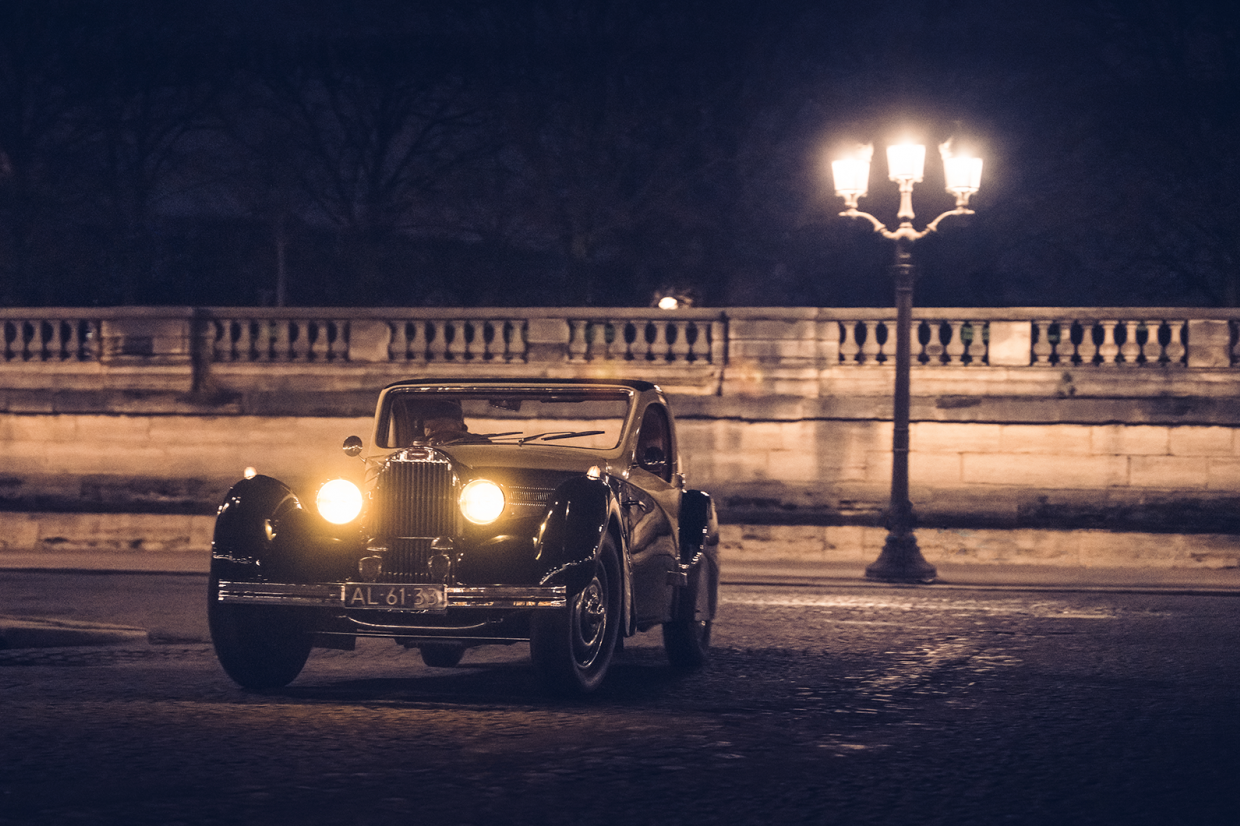 For all its delicacy, in its day the Atalante was among the fastest ways to cover long distances in comfort
For all its delicacy, in its day the Atalante was among the fastest ways to cover long distances in comfort
To say the name has a mystique that is the pre-war equivalent to Ferrari doesn’t quite do the marque justice, although it was certainly the prototype for the irrational devotion both makes have inspired: men and women have sold houses and committed heinous crimes simply to capture a Bugatti.
The colourful history of this T57 bears testimony to the way these cars have always attracted ‘interesting’ owners who have collected, coveted and written in scholarly terms about this marque, long before it was fashionable.
Transcending the generation gap that today threatens the relevance of so many less exalted pre-war vehicles, Bugattis have been forged and faked like old masters and are still making headline-grabbing figures at auction.
Images: Olgun Kordal, Archives Pierre-Yves Laugier
Thanks to: Artcurial
Enjoy more of the world’s best classic car content every month when you subscribe to C&SC – get our latest deals here
SRC: https://www.classicandsportscar.com/








